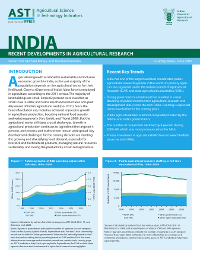Authors:
Pal, Suresh; Rahija, Michael; Beintema, Nienke
Year:
2012
Publisher
International Food Policy Research Institute (IFPRI); and Indian Council of Agricultural Research (ICAR)
Back to:
India has substantially increased its public funding of agricultural research since the late 1990s. This trend will likely continue in years to come. The Indian government’s strong commitment to agricultural R&D has been rewarded with high economic and social returns to research investments. Nonetheless, India’s research intensity ratio, measured as public agricultural R&D spending as a share of agricultural output, continues to be relatively low. In its upcoming twelfth ive-year plan, the Indian government seeks to address this deiciency by committing 1 percent of AgGDP to agricultural R&D. However, given the scope of the challenges facing the nation, an intensity ratio of less than 2 percent will almost certainly be insuicient.
ICAR and the SAU system are making a concerted efort to better target research and to improve coordination of programs across the various institutions. Deliberate eforts are also being made to foster partnership with the farming community and with other stakeholders, so as to accelerate the low of technology.
The quality of India’s research staf has improved, as evidenced in the growing share of PhD-qualiied researchers. But the number of researchers has fallen by 8 percent since the turn of the millennium. This drop is primarily driven by declining research capacity at the SAUs due to budget constraints. Without an efective policy response, the state research capacity will decline further, leading to less time spent on research by SAU faculty. A inal concern is the fragmentation of SAUs along disciplinary lines. A trend toward greater specialization could hinder integrated technology development and demonstration on farmers’ ields.

